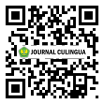HAPPINESS IN THE CELEBRATION OF CHINESE NEW YEAR
DOI:
https://doi.org/10.37301/culingua.v2i1.13Keywords:
Chinese Lunar New Year, greetings, emotion, P.SantangeloAbstract
Gong xi facai is a Chinese New Year greeting that is commonly spoken, heard, and written by people. Even if we don't know what it means, we guess the meaning must be good. The problem is what is the meaning of each word and the meaning of the sentence as a whole so that it can be concluded that the sentence is an expression of a joyful? Are there no other feelings? Since the sentence is considered a text, it will be examined which words express emotion, what kind of emotions they are. The goal is to express clearly what is meant by that sentence. To find out what kind of emotions it contains, Santangelo's theory (2000) will be used to detect which words express emotion and belong to which class. The data are Chinese Lunar New Year greetings written in Han characters. There is Indonesian-language data in the form of Chinese New Year pantun. Based on the analysis of the meaning components of emotions, the data are classified into several domains, such as Chinese New Year greeting, success in business, health, family, education, etc. The novelty of this research is to analyze the meaning components of emotional sentences so that emotional content can be identified precisely. This research will enrich research on emotions in the field of greetings for the Chinese New Year that has not been done much.
References
Ekman, P. (2003). Emotion Revealed: Understanding Face and Feelings. London: Phoenix.
Feldman, et.al. (2016). Handbook of Emotion. New York: The Guildford Press.
Izhatullaili and Sutami, H. (2018). “Memaafkan (To Forgive) in the Novel Hujan dan Teduh”. Paper presented in International Conference on Transdisciplinary Linguistics (ICTL) held by Faculty of Humanities Universitas Indonesia, October 10-12, 2018.
Lazarus, R.S.(1991). Emotion and adaptation. New York: Oxford University Press.
Nida, E.A. (1979). Componential Analysis of Meaning. The Hague, Paris: Mouton Publishers.
Niemeier, S. (1984). The language of emotions: Conceptualization, expression, and theoretical foundation. Amsterdam: Jhon Benjamin Publishing Company.
Nurazijah, M., and Sutami, H. (2018). “Expressions of Love in Sundanese Language: A Study of Emotion and State of Mind”. Paper presented in International Conference on Transdisciplinary Linguistics (ICTL) held by Faculty of Humanities Universitas Indonesia, October 10-12, 2018.
Oehler, K. (1987). An Outline of Peirce’s Semiotics. In M. Krampen (Ed.), Classics of Semiotics. New York and London: Plenum Press.
Ogden, C. K., & Richards, L. A. (1923). The Meaning of Meaning: An introduction to semantic structure. London: Routledge & Kegan Paul Ltd.
Peirce, C.S. (1931-35). Collected Papers, vol 1-6. Ed.C. Hartshorne and P.Weiss. Cambridge: Harvard University Press.
Santangelo, P. (1995). A Research on Emotions and States of Mind in Late Imperial China: Preliminary Results. In P. Sangelo (Ed.), Ming Qing Yanjiu (hal. 101–209). Napoli, Roma: Dipartimento di Studi Asiatici Istituto Universitario Orientale Napoli.
Santangelo, P. (2003). Sentimental Education in Chinese history: An interdisciplinary textual research on Ming and Qing Sources. Boston: Brill.
Sutami, H. (2017). “Unsur budaya dalam suasana hati”. Proceeding Seminar Leksikologi dan Leksikografi. ISSN: 2407-1307, 172-179. Depok: FIB.
Sutami, H. (2018). “Causal Relationship as an Expression of Happiness and Joyfulness”. Advances in Social Science, Education and Humanities Research, volume 280. International Seminar On Recent Language, Literature, And Local Culture Studies (BASA 2018). Copyright © 2018, the Authors. Published by Atlantis Press. (http://creativecommons.org/licenses/by-nc/4.0/). Pp. 253-262.
Sutami, H. (2021). “Pembentukan Karakter Bermuatan Watak/Disposisi melalui Cerita Anak”. Fetschrift for Prof. Dr. Riris K.Toha Sarumpaet. Will be published in February 2021.
Downloads
Published
Issue
Section
License
Copyright (c) 2021 Hermina Sutami

This work is licensed under a Creative Commons Attribution 4.0 International License.









